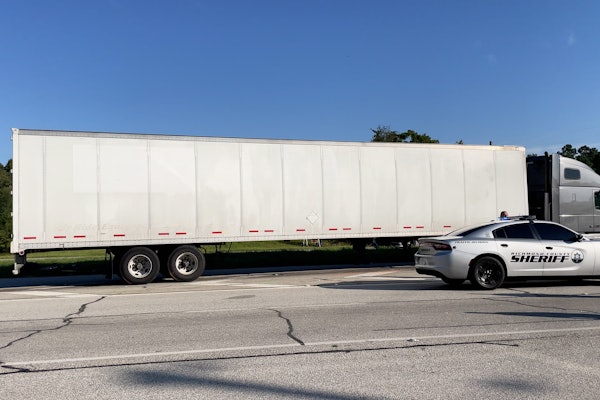Medium-term interest rates are climbing, potentially eliminating what had been a great benefit for the truck buyer – low interest rates.
During the late 1990s, many lenders rolled out their welcome mats to carriers as new equipment sales soared. In 2001 and 2002, many lenders were forced to cut their losses and abandon the industry. What a difference a couple of years can make.
“What really hurt lenders was pre-9/11,” says Steve Parker, vice president of commercial finance for Transportation Alliance Bank, a subsidiary of Flying J that provides financial products and services to the trucking industry. An oversupply of fleet-spec’d trucks that entered the resale market in 2001 and 2002 drove down equipment values and turned the balance sheets of many carriers upside down, Parker says.
Repossessions were already growing by the time terrorists attacked the United States on Sept. 11, 2001, but the shock to the economy meant there would be no quick return to the high demand of the late 1990s. With a glut of late-model used equipment looking to be a chronic problem, many lenders left the trucking market, and credit became even tighter.
Much of the used-truck surplus was swept up by the demand for late-model trucks driven by the October 2002 switchover to lower-emissions engines. And last fall, the industry started to see a sustainable economic recovery, says Dean Clark, managing director and head of transportation for CitiCapital.
So now, low-mileage used trucks are scarce, interest rates remain low and many lenders have once again entered the trucking industry. Many carriers had no choice but to renew their fleets to avoid mounting maintenance costs. In 2004, new-truck sales are better than at any point since the late 90s, Parker notes. But while debt financing is strong, experts say equipment leasing could enjoy a banner year due to lingering concerns over 2007 technology and tax benefits that could soon disappear.
The price is right
An upsurge in the demand for used trucks plays a large factor in the improved credit strength of carriers today, and is one reason why more lenders have returned to the market. The increase in used truck prices comes as no surprise when considering the limited number of trucks produced in 2001 through 2003 was less than the trucks needed for fleets’ replacement cycles in 2004, Clark says. In addition, the growing backlog of new equipment orders has increased the demand for used equipment.
“The scarcity of low mileage, premium used trucks has forced the market perception of a low-mileage used truck to increase from less than 300,000 miles to less than 500,000,” says Tim Henebry, president of Paccar Financial Corp. Higher used equipment values translate to lower payments on new equipment purchases for carriers who are planning to trade-in equipment for new purchases in 2004.
“We have seen an improvement of trade values this year,” says John Pope, chief executive officer of Cargo Transporters, a 400-truck carrier based in Claremont, N.C. “There seems to be an increasing appetite for good, used equipment. It has been reflected in the numbers we have received from our local dealer on trades.”
“The current market for used trucks and availability of finance sources is a double plus for our industry,” Henebry says. “Used truck customers can take advantage of current market conditions to get into new trucks more easily. which makes it an excellent time for those with existing trucks to trade up to new trucks.”
With trade-in values high, it’s no coincidence that 2004 is on pace to be the best new-truck sales year since the late ’90s. The large number of trucks ordered this year is not just because of favorable trade-ins, however. Fleets appear to be timing their trade cycles with 2007 in mind.
“One only has to look at the orders received by the truck OEMs in the first four months of 2004,” says Walter Mascherin, chief operating officer of Volvo Commercial Finance. “Well over 120,000 orders have been placed with the OEMs which would indicate that most carriers are timing their equipment buying with the introduction of the EPA regulations that come into effect in 2007.”
Loan or lease?
Because of good trade-in values and the low interest rates available today, debt financing may appear to be the best way to add or replace equipment in 2004. CitiCapital’s Clark, for example, says that interest rates are lower now than he’s seen in his 25 years in the transportation industry. Even carriers who have not added equipment or replaced equipment in the past year or so are taking advantage of low interest rates to refinance existing debt, Parker says.
In addition to low interest rates, another incentive for carriers to finance their equipment purchases is the “bonus depreciation” tax benefit that started in 2001. This law allows carriers to take an additional 50 percent of the first year’s depreciation. The additional depreciation benefit allowed the owner of a new vehicle to write-off either 60 percent or 67 percent of the asset’s cost in the first year, Henebry says.
For carriers planning to make a healthy profit in 2004, this depreciation law can be a big deciding factor in whether to buy or lease new equipment.
“Our financing package this year was that of traditional borrowing because of a need for the depreciation,” says Cargo Transporter’s John Pope.
Another incentive to finance equipment may come in special deals offered by truck manufacturers’ financing companies. In April, for example, International Finance Group, the financing arm of International Truck and Engine Corp., concluded a program that offered customers a down payment of up to $2,000 per truck if they financed the purchase with International. “It’s fairly uncommon for us to not have a special,” says Tom Guse, vice president of marketing for International Finance Group.
But lenders expect leasing to gain ground in 2004. Medium-term interest rates are climbing, potentially eliminating what had been a great benefit for the truck buyer – low interest rates, Henebry says.
Carriers’ lackluster financial performance over the past few years is also a reason why leasing is growing in 2004. Depreciation write-offs may not be needed by companies working to shed debt from balance sheets. In addition, the uncertainty of how engine makers will respond to the 2007 EPA emission standards is already beginning to influence more carriers to lease equipment on a short term in anticipation of a pre-buy in 2007.
“Fleet customers are upgrading their equipment in 2004, with the expectation that they will ‘pre-buy’ new trucks prior to the January 1, 2007 enhanced emissions EPA deadline,” Henebry says. As a result, fleets want to have “early out” options that are available only through leasing.
Time for the lease
Another significant factor in leasing’s favor is the fact that the depreciation bonus is scheduled to retire Jan. 1, 2005. For the lender, the accelerated write-off under existing bonus depreciation rules results in lower monthly lease payments for the customer and a lower total cost for the truck, Henebry says.
“I believe that leasing is going to grow,” Guse says. In April, International Finance Group introduced a new fair market value (FMV) lease for its heavy and medium-duty trucks called Diamond Truck Lease. The program allows fleets to lease trucks for a specified time period and either return the unit or buy it at FMV at the end of the lease, or re-lease the unit for an extended term. Lease terms range from 36 months to 72 months, he says.
Likewise, CitiCapital has started offering new FMV lease products with flexible lease terms. “If the customer is skeptical of continuing to run the equipment beyond 2007, or if they want to make an early trade to get out of the equipment to get a current engine, CitiCapital offers an early-out option to make the decision closer to ‘D-Day,'” Clark says.
Major fleet customers of Paccar Financial, for example, are financing an increasing proportion of their equipment with FMV leases, Henebry says. The FMV lease eliminates the remarketing activities required if the customers finance their equipment with traditional debt financing, he says. And the average lease term requested by the lessee has been shortened to position the fleet for a “pre-buy” prior to 2007. “The FMV and pre-buy fleet strategy allows a fleet to cycle through two trucks before the new rules take effect,” Henebry says.
With engine makers planning to stick to their current low-emissions technology, concern over 2007 technology may not reach the levels seen in 2002. But for fleets worried about the next generation of engines, leasing in the short term may offer some ability to optimize the timing of future purchases.
Going with SBA
While many lenders have returned to the trucking industry, increasing the financing options for successful fleets, many small carriers and startups have a difficult time obtaining financing through traditional means. Through the Small Business Administration, however, carriers can obtain low-interest financing without a history of financial success.
Lenders typically want to see two to three years of profit before loaning to a trucking company, says Steve Parker, vice president of commercial loans for Transportation Alliance Bank, a wholly owned subsidiary of Flying J, Inc. that offers financial products and services, including SBA loans, to trucking companies.
After the past few years in the trucking industry, finding a small carrier that can show two to three years of profits is “a difficult thing to come by,” Parker says. Banks also want to see positive cash flows, he adds, but “not many carriers are in that position.”
The SBA makes it possible for lenders such as TAB to look at a loan structure or a customer they normally wouldn’t, Parker says. If the bank can get SBA to believe in the loan, the bank gets an SBA guarantee on a portion or percentage of the loan. There is a downside, however.
“It is going to involve a lot more paperwork than a traditional loan,” Parker says. “If you are just doing equipment, there are lenders who do that on a one-page application. The SBA wants to see three years of tax returns, financial statements, projections, and a business plan.” SBA also wants a personal guarantee that can tie up personal assets.
Tammy Guite started Wausau, Wis.-based Elite Carriers in August 1999 with the assistance of an SBA loan. Guite used the SBA loan to buy 20 used trailers. She used personal investments and a loan from Paccar Financial to buy a four-tractor trucking firm from her father-in-law as well as several new trucks.
“We used outside financing beyond that first SBA loan only because we were able to get it,” Guite says. Compared to the other loans, the SBA loan was a better rate and did not require as much down.
The company has posted profitable years since starting, Guite says. With the help of husband Greg, who left a job at a local trucking company to join Tammy in the management of Elite Carriers, the company has grown to a 65-truck company generating $10 million a year in revenue and employing 100. Due to this success, SBA honored the Guites as the 2004 Wisconsin Small Business Persons of the Year.








